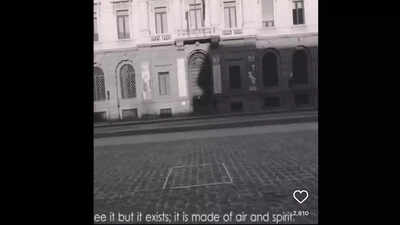ARTICLE AD BOX

Artist sells invisible sculpture for over $18K (Image source: salvatore_garau/instagram)
In an era where digital assets are reshaping creativity and NFTs are selling for millions, an Italian artist has taken the concept of intangible art a step further—by selling nothing.
That’s right. In 2021, Salvatore Garau, a Sardinian-born conceptual artist, sold an invisible sculpture titled “Io Sono” (Italian for “I Am”) for over $18,000. The sale came with no frame, no form, and no physical manifestation. All the buyer received was a certificate of authenticity—a document verifying the existence of something the naked eye will never see. The controversial piece has since ignited a passionate global conversation about what constitutes art, the evolving nature of value in creative works, and the metaphysical dimensions of expression.Far from a passing gimmick, Garau’s work is embedded with philosophical depth, drawing from quantum theory, spirituality, and centuries of conceptual tradition. As some applaud his genius and others decry the absurdity, the invisible sculpture has become a mirror reflecting our modern obsessions with perception, belief, and the commodification of ideas.
Who is Salvatore Garau? The artist behind the invisible masterpiece
Salvatore Garau, born in 1953 in Sardinia, Italy, has long been a provocateur in the art world.
With a background in music, he began his career as a drummer in the progressive rock band Stormy Six before transitioning to painting and conceptual installations. Garau’s previous works often flirt with abstraction and metaphysics, exploring themes of space, void, and human presence.His leap into “immaterial” sculptures marks a radical evolution of his practice, combining traditional ideas of spiritual and metaphysical art with cutting-edge commentary on modern consumerism, belief systems, and the intangible economy.
Io Sono: The sculpture made of air and spirit
'Io Sono' was auctioned by Italian art house Art-Rite in May 2021, with a starting estimate of $7,000 to $11,000. The final bid closed at a staggering €15,000 (approximately $18,300 USD). What the buyer received was a certificate, not a canvas or sculpture, attesting to the artwork’s existence.The artwork is meant to be displayed in a 5-by-5-foot private space without lighting or climate control. According to Garau, the sculpture exists in the viewer’s imagination. In a video statement, the artist emphasised:“You don’t see it but it exists.
It is made of air and spirit… The vacuum is nothing more than a space full of energy.”He invokes quantum physics to justify the concept, particularly referencing the Heisenberg uncertainty principle, which posits that even "empty" space retains quantum energy.
Why people are paying for the ‘invisible’
Garau’s invisible sculpture didn’t emerge in a vacuum—pun intended. The sale happened in parallel with the explosive rise of NFTs (Non-Fungible Tokens).
Just months earlier, digital artist Beeple sold a JPEG NFT titled “Everydays: The First 5000 Days” for $69.3 million through Christie’s.This modern appetite for owning the immaterial—digital files, smart contracts, virtual land—has primed collectors to explore radical new frontiers in conceptual ownership. Io Sono is not an anomaly but part of a broader movement where value increasingly resides in ideas, authenticity, and proof of uniqueness, rather than material form.
Garau’s defense: Is the immaterial still art
To Garau, the sculpture is not a joke. It is a philosophical challenge:“After all, don’t we shape a God we’ve never seen?”This bold comparison touches a nerve. Like religion, conceptual art demands faith, imagination, and personal investment. If the invisible can be divine, why can’t it also be art?The artist further argues that the work democratizes creativity. Since Io Sono is immaterial, anyone can imagine it.
It levels the playing field, removing artistic elitism by transferring agency to the audience’s inner world.
Other invisible works by Salvatore Garau
Garau didn’t stop with Io Sono. In February 2021, he unveiled “Buddha in Contemplation”, another immaterial sculpture, in Milan’s Piazza della Scala. Viewers were invited to engage not with form, but with presence—a silent spiritual contemplation.In June of the same year, Garau installed “Afrodite Piange” (Aphrodite Cries) in front of the New York Stock Exchange.
Again, there was no visible object—only a designated space and an invitation to reflect.
Art or absurdity? The public and critical reaction
The internet, unsurprisingly, had mixed feelings. Critics mocked the sculpture as a scam, a publicity stunt, or the death knell of artistic integrity. Memes proliferated across platforms, with users joking about selling their own invisible creations.But art critics and philosophers have been more divided. Some hailed Garau’s work as a bold return to conceptualism in the vein of Marcel Duchamp, Yves Klein, and Piero Manzoni, all of whom questioned the material limits of artistic expression.
Others, however, see it as symptomatic of a market obsessed with novelty and shock value—where art loses meaning in pursuit of viral headlines.



.png)
.png)
.png)
















 1 week ago
8
1 week ago
8









 English (US) ·
English (US) ·